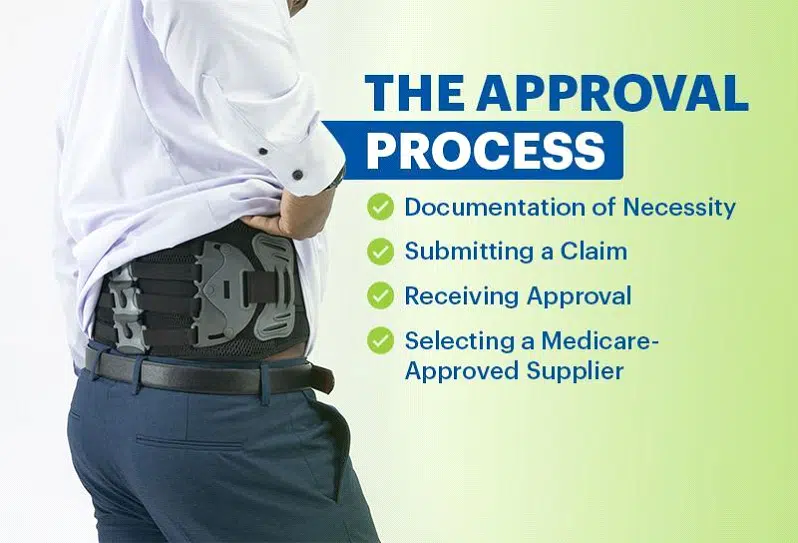Dealing with back issues can be daunting, and finding the right support is crucial for your well-being. If you’re on Medicare, you may be eligible for coverage for back braces, which can provide essential support and pain relief. Understanding the steps to secure Medicare coverage for a back brace can save you time, money, and stress. In this step-by-step guide, we will walk you through the process, ensuring you’re well-informed and prepared to navigate the complexities of Medicare.
The Vital Role of Back Braces
Back braces serve as a pivotal aid for individuals with spinal issues, offering pain relief by limiting harmful movements and supporting a stable healing environment, especially post-surgery. They not only facilitate recovery but also enhance daily mobility, allowing for more active engagement in life’s activities. As preventative tools, they safeguard against potential back injuries for those at risk. Long-term use can lead to improved posture and spinal stability, aiding in the management of chronic conditions like scoliosis. Ultimately, a back brace is more than just a supportive garment; it’s a key component in maintaining spinal health and improving the quality of life for those with back problems.
Understanding Medicare Coverage
When it comes to managing back pain, a back brace can be an indispensable tool, offering both support and relief. The good news for those covered by Medicare is that back braces are often included under the umbrella of covered medical equipment. However, understanding the nuances of this coverage is vital to maximize your benefits.
1. Eligibility Requirements
Medicare is a complex program with various parts, each covering different aspects of healthcare. Parts B and D of Medicare can be particularly relevant when it comes to coverage for back braces:
- Medicare Part B generally covers what’s considered “Durable Medical Equipment” (DME) as long as your doctor certifies that it is medically necessary. To be eligible, you must have a written prescription from a Medicare-enrolled physician and be using a Medicare-enrolled supplier.
- Medicare Part D may cover certain pain medications that your doctor might prescribe in relation to the back condition being treated by the brace. While Part D doesn’t cover the brace itself, it’s an important part of the overall pain management and treatment process.
Understanding these eligibility requirements is crucial. Your doctor and the equipment supplier can both assist in navigating these parts to ensure you receive the coverage you’re entitled to.
2. Durable Medical Equipment (DME)
Medicare defines Durable Medical Equipment as items that are necessary for your health, can be used repeatedly, and are suitable for home use. Back braces are categorized under DME because they are designed to treat a medical condition or injury by providing support to the spine, thereby improving function or preventing further injury.
For a back brace to qualify for coverage, it must be:
- Prescribed by a physician as medically necessary.
- Able to withstand repeated use.
- Not useful to someone who isn’t sick or injured.
- It is expected to last for at least three years.
Medicare will generally cover 80% of the Medicare-approved amount for the back brace, with the Part B deductible applied, and you’re responsible for the remaining 20%.
3. The Approval Process
Getting a back brace approved as DME involves several crucial steps:
- Documentation of Necessity: Your healthcare provider must first document your need for a back brace. This involves a thorough examination and a written prescription detailing your specific diagnosis and the reason why the brace is essential for your treatment.
- Selecting a Medicare-Approved Supplier: You must obtain your back brace from a supplier enrolled in Medicare for the cost to be covered. Suppliers who are not enrolled could result in you bearing the full cost of the brace.
- Submitting a Claim: Once you receive your back brace, the supplier will usually submit a claim to Medicare on your behalf. However, confirming this with the supplier is important to ensure the claim is processed.
- Receiving Approval: If all the paperwork is in order and the brace is a covered item, Medicare will approve the claim and pay the supplier directly for 80% of the approved amount after your deductible is met.
To facilitate a smooth approval process, ensure that both your healthcare provider and the equipment supplier are in good standing with Medicare. They should be able to guide you through the necessary paperwork and any additional requirements to ensure that your claim is submitted correctly.
Step-by-Step Guide to Coverage
Securing Medicare coverage for a back brace can be a step-by-step process that requires careful attention to detail. Here’s an expanded guide to help you navigate the procedure smoothly:
1. Consult with Your Healthcare Provider
Before you can proceed with getting a back brace through Medicare, the first and most critical step is to consult with your healthcare provider. This medical professional will evaluate your condition and determine the necessity of a back brace for your treatment.
They will need to provide:
- A detailed written prescription.
- Documentation that outlines the diagnosis and the medical reasons why a back brace is required.
- Specifics about the type of back brace needed and the expected duration of use.
The documentation from your healthcare provider must clearly state how the back brace will help with your specific condition. This is essential because Medicare coverage hinges on proving that the brace is medically necessary and not just for comfort or convenience.
2. Choosing the Right Brace
With your prescription in hand, the next step is selecting an appropriate back brace. It’s important to choose a brace that not only fits your medical needs but also meets Medicare’s standards. You should:
- Discuss the options with your healthcare provider.
- Look for braces that are classified as DME under Medicare guidelines.
- Ensure the chosen brace is from a Medicare-approved brand or supplier to qualify for coverage.
3. Dealing with Suppliers
Finding a Medicare-approved DME supplier is crucial. A supplier enrolled in Medicare agrees to accept the assignment, meaning they accept the Medicare-approved amount as full payment for the brace. To find an approved supplier, you can:
- Use the Medicare.gov supplier directory.
- Contact your Medicare plan directly for a list of approved suppliers.
- Verify that the supplier accepts Medicare assignment to avoid unexpected costs.
4. Filing a Claim
Most Medicare-enrolled suppliers will file a claim on your behalf. However, understanding the process can ensure that there are no hitches:
- Make sure the supplier has your correct Medicare information.
- Provide all the necessary documentation from your healthcare provider.
- Keep personal copies of all forms and prescriptions submitted.
If you need to file the claim yourself, you can do so by completing the ‘Patient’s Request for Medical Payment’ form (CMS 1490S) and submitting it to your Medicare Administrative Contractor (MAC).
5. Handling Denials
If your claim for a back brace is denied by Medicare, don’t despair. You have the right to an appeal. The denial notice will provide specific reasons for the denial and instructions on how to appeal. To prepare for a possible appeal:
- Review the denial notice carefully to understand the reasons for rejection.
- Gather any additional information or documentation supporting the back brace’s medical necessity.
- Submit a formal appeal request within the notice’s specified timeframe.
Maximizing Your Coverage
Maximizing your Medicare coverage for a back brace means ensuring that every step of the process is handled correctly. By following these steps diligently, you stand the best chance of getting your back brace covered with minimal personal expense. Remember:
- Regularly review your Medicare plan to understand any changes in coverage.
- Keep all receipts and documents related to your back brace.
- Stay in communication with your healthcare provider and DME supplier throughout the process.
By meticulously following this step-by-step guide, you can navigate the intricacies of Medicare coverage for a back brace with greater ease and confidence, ensuring that you receive the support you need for your back health.
Read More: How Often Will Medicare Pay for Back Braces?
Understanding Your Plan
Grasping the details of your Medicare plan is key to effectively managing your health needs and finances. Here’s an extended look into understanding your plan when it comes to back brace coverage.
1. Costs and Reimbursements
Navigating the financial aspects of Medicare can be challenging. Here’s what you need to know about the costs related to obtaining a back brace:
- Deductibles: Understand the amount you must pay before Medicare begins to cover your costs.
- Coinsurance: Even after meeting your deductible, Medicare Part B typically covers 80% of the approved amount, leaving you responsible for the remaining 20%.
- Copayments: If you’re enrolled in a Medicare Advantage Plan (Part C), you might have copayments for DME, like back braces.
Medicare will reimburse the approved amount for a back brace, assuming it is medically necessary. However, you must meet the Part B deductible first, and then Medicare will cover its share. Always verify the exact figures with Medicare or your healthcare provider to avoid surprises.
2. Maintenance and Replacement
Medicare acknowledges that DME, including back braces, may need replacement over time due to wear and tear:
- Standard Coverage: As a rule of thumb, Medicare may cover a replacement back brace every five years.
- Exceptional Circumstances: If your brace is lost, stolen, or damaged beyond repair in an accident or natural disaster, you might be eligible for a replacement sooner.
- Documentation for Replacement: You’ll need a new prescription from your healthcare provider and documentation to support the necessity for a replacement.
Conclusion
Wrap up by reiterating the importance of back braces for those with spinal issues and the benefits of understanding how to work with Medicare to cover the costs. Encourage readers to take proactive steps and seek help from professionals when needed.
Keyphrase
Medicare Coverage for Back Braces
Keyphrase Synonym
- how much does Medicare pay for a back brace
- back braces covered by Medicare
- how often does Medicare pay for back braces
- how often will Medicare pay for a back brace
- Does Medicare cover back braces
- Will Medicare pay for a back brace
- Does Medicare pay for a back brace
Tags
- Medicare
- Back Brace
- Spinal Support
- Health Insurance
- Medical Equipment Coverage









